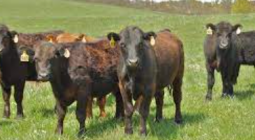Climate impact labels could help people eat less red meat

Information on environmental impact can persuade consumers against carbon-heavy food choices, says study
Climate impact labels on foods such as red meat are an effective way to get people to stop choosing options that negatively affect the planet, a study has found.
Policymakers have been debating how to get people to make less carbon-heavy food choices. In April, the Intergovernmental Panel on Climate Change (IPCC) report urged world leaders, especially those in developed countries, to support a transition to sustainable, healthy, low-emissions diets.
In the UK, Henry Dimbleby, the government’s food tsar, recently said it was politically impossible for a government to tell people to stop eating as much meat. About 85% of agricultural land in England is used as grazing pasture for animals such as cows or to grow food which is then fed to livestock. Dimbleby believes a 30% meat reduction over 10 years is required for land to be used sustainably in England, while Greenpeace argues for a 70% reduction.
The clinical trial, published in the journal Jama Network Open, has found that consumers respond well to climate labelling on their foods.
Participants in the study, which used a nationally representative sample of adults in the US, were shown a fast food menu and prompted to select one item they would like to order for dinner. Participants were randomised to view menus with one of three labels: a quick response code label on all items (control group); green low–climate impact label on chicken, fish or vegetarian items (positive framing); or red high–climate impact label on red meat items (negative framing).
The low–climate impact condition menu stated: “This item is environmentally sustainable. It has low greenhouse gas emissions and a low contribution to climate change.” The high–climate impact condition menu said: “This item is not environmentally sustainable. It has high greenhouse gas emissions and a high contribution to climate change.”
Compared with participants in the control group, 23.5% more participants selected a sustainable menu item when menus displayed high–climate impact labels and 9.9% more participants selected a sustainable menu item when menus displayed low–climate impact labels. Across experimental conditions, participants who selected a sustainable item rated their order as healthier than those who selected an unsustainable item, according to a mean perceived healthfulness score.
Some may disagree with this labelling; intensively produced chicken has been found to be damaging for the environment, as has some farmed and trawled fish.
The study authors, from Johns Hopkins and Harvard universities, said: “Animal-based food production, primarily driven by beef production, is responsible for 14.5% of global greenhouse gas emissions and is an important modifiable contributor to climate change.
“In the United States, meat consumption, red meat consumption in particular, consistently exceeds recommended levels based on national dietary guidelines. Shifting current dietary patterns toward more sustainable diets with lower amounts of red meat consumed could reduce diet-related greenhouse gas emissions by up to 55%.”
They found that telling people that a food type had negative environmental impacts was more effective than informing them that a food was a more sustainable choice.
The authors said: “We found that labelling red meat items with negatively framed, red high–climate impact labels was more effective at increasing sustainable selections than labelling non–red meat items with positively framed, green low–climate impact labels.”
cover photo: The study showed participants a fast food menu which used three different types of labelling. Photograph: Graham Turner/the Guardian




